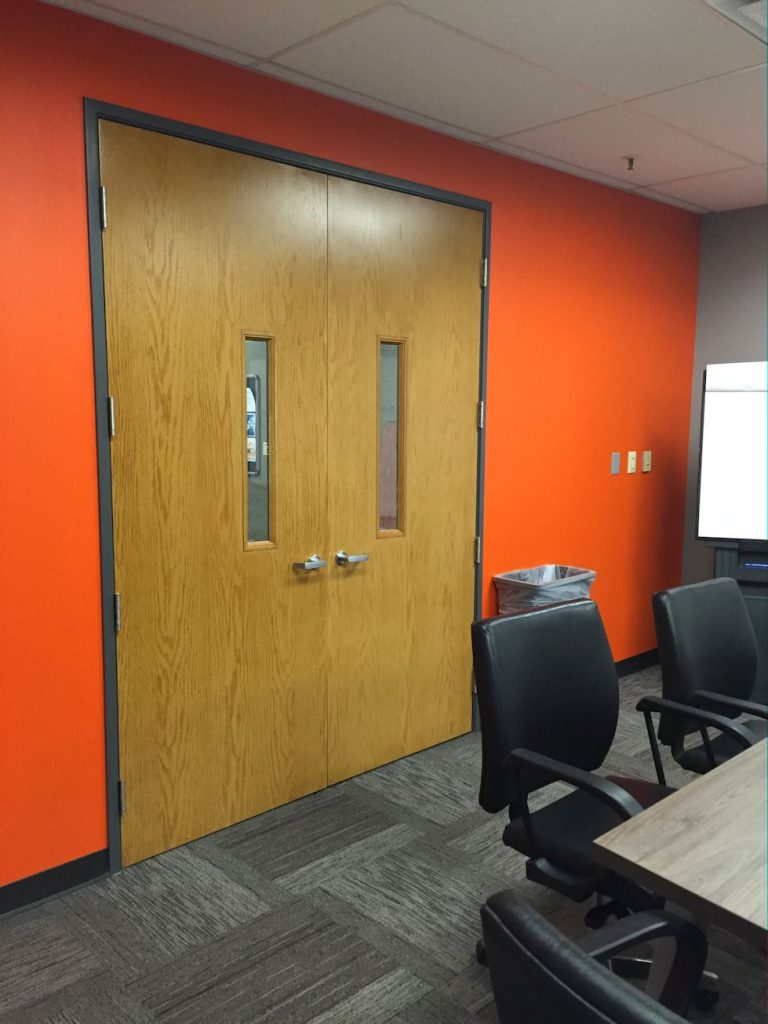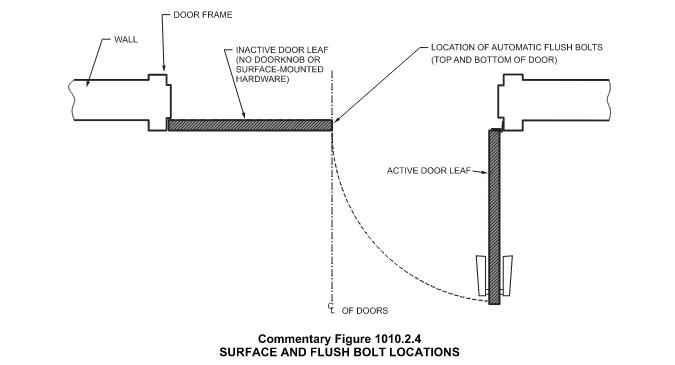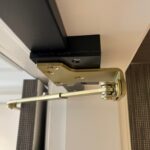
If you’re thinking that the doors in this photo are not code-compliant, check out the link at the bottom of this post.
Today’s Quick Question was sent to me by a contractor:
On a pair of doors, is it acceptable to install a dummy lever on the inactive leaf if that door is equipped with flush bolts?
Before I go on, I just have to say that I was really excited to have a contractor asking me this question. He saw the dummy lever in the hardware specification and didn’t think it was allowed by code. In my many years of experience working with hardware schedules and specs, it would have been very unusual for the GC to pick up on a detail like this.
My response to the contractor was that it’s ok to have dummy trim on the ingress side (the outside) of the inactive leaf, but not on the egress side. The International Building Code (IBC) states:
Manual bolts, automatic flush bolts and constant latching bolts on the inactive leaf of a pair of doors in accordance with Table 1010.2.4, provided that the inactive leaf does not have a doorknob, panic hardware, or similar operating hardware.
Although the code excerpt above doesn’t specifically reference dummy trim, in my interpretation it would not be permitted. Here is a reference from the IBC Commentary:
Automatic flush bolts on one leaf of a pair of egress doors are acceptable, provided the leaf with the automatic flush bolts is not equipped with a doorknob or other hardware that would imply to the user that the door leaf is unlatched independently of the companion leaf.
The contractor then asked for evidence that dummy trim was acceptable on the access/ingress side of the door. Hmmm…because I said so? 🙂 I immediately added this to my code development wish list because it should be a super easy fix. But until 2030 when we can try to clarify this in the model codes, we have to consider the intent.
 The model codes are typically addressing egress, not ingress. For example, the egress side of a door in the means of egress can not be lockable (yes – there are some exceptions), can not be concealed with a mural (yes – there is an exception to this also), and can’t have dummy hardware on the inactive leaf. The dummy hardware on the egress side of the inactive leaf might be confusing to a building occupant – they could try to exit through the leaf with the flush bolts because it looks like it has operable hardware.
The model codes are typically addressing egress, not ingress. For example, the egress side of a door in the means of egress can not be lockable (yes – there are some exceptions), can not be concealed with a mural (yes – there is an exception to this also), and can’t have dummy hardware on the inactive leaf. The dummy hardware on the egress side of the inactive leaf might be confusing to a building occupant – they could try to exit through the leaf with the flush bolts because it looks like it has operable hardware.
In my interpretation of the model codes, the access/ingress side of the door is not subject to the restrictions that apply to the egress side. The access side of the door can be lockable. The access side of the door could be painted as part of a mural, concealing the door that might only be used for egress. And I can’t think of any life safety related reason why a pair of doors couldn’t have a dummy lever on the access side, if the architect was a fan of symmetry for aesthetic reasons. Personally I think the dummy lever could be confusing on the access side too – especially if the active leaf had latching hardware (which lever do you turn for access?). But symmetry has never really been my thing, and confusion about access is not the focus of the model codes.
Please note that I am not an AHJ, and this is my opinion based on almost 40 years of experience with thousands of doors. But if we look at the intent of the code in the absence of prescriptive language regarding the access side vs. the egress side, a dummy lever would not be permitted on the egress side of a door with flush bolts, but a dummy lever on the access side of a door with flush bolts would not be a life safety issue.
And one more thing…for illustration purposes, the photo I used for this post has lever handles on the egress side of both leafs of the pair, but it’s actually code-compliant! This pair does not have an inactive leaf with flush bolts. Both doors are active – they have Schlage LM9200 multi-point locks. You can read more about this application here.
You need to login or register to bookmark/favorite this content.








I hate people that read every word in the code book!!!
But you read every word and apply it.
Are you sure you want to add more words to the book?
Good article and would agree on no hardware on the egress side.
Just a couple more words, Charles! 🙂
– Lori
Another great post Lori!
I agree… a GC picking up on this is impressive & certainly unexpected in my mind.
Persoanally, I wouldn’t apply a dummy trim on the ingress of the inactive door myself. I’m a stickler for aesthetics too; but in this instance, the inconvenience and frustration of folks grabbing a non-functioning & non-operable door trump the symmetrical appearance of having a lever on both leaves all day long!
This is an ongoing problem, designers don’t understand that operating a swinging door is essentially an asymmetric activity. Increasing the visual symmetry almost always degrades the performance of the opening.
On a glossy door surface that shows fingerprints easily it makes sense to use dummy trim on the AFB leaf non-egress side. The hardware on the other side ( a cylinder or reader) should make it obvious which door to open.
I run into this monthly. I agree with your assessment and that is exactly what I tell them. 9 times out of 10 after you present it to them, they cancel the dummies.